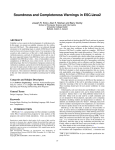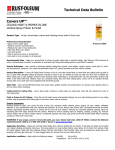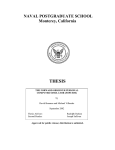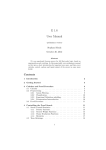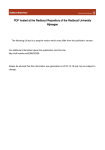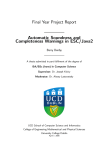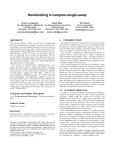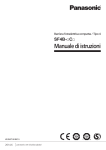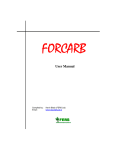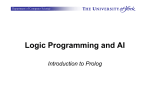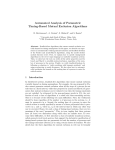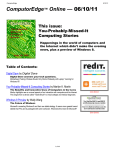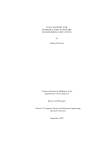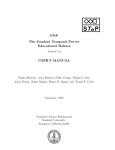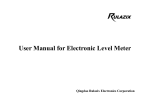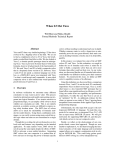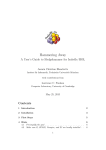Download Soundness and Completeness Warnings in ESC/Java2
Transcript
Soundness and Completeness Warnings in ESC/Java2
Joseph R. Kiniry, Alan E. Morkan and Barry Denby
School of Computer Science and Informatics
University College Dublin
Belfield, Dublin 4, Ireland
ABSTRACT
on intentional trade-offs of unsoundness with other properties of the checker, such as efficiency and the frequency
of false alarms. ESC/Java2 being incomplete means that it
emits false negatives. That is, it warns of potential errors
when it is impossible for these error to occur in any execution of the program. Since ESC/Java2 attempts to check program properties that are, in general, undecidable, some degree of incompleteness is inevitable. In addition, the developers of ESC/Java2 were willing to accept some avoidable
areas of incompleteness in order to improve performance
and to keep the tool simple.
Usability is a key concern in the development of verification tools. In this paper, we present an usability extension
for the verification tool ESC/Java2. This enhancement is
not achieved through extensions to the underlying logic or
calculi of ESC/Java2, but instead we focus on its human interface facets. User awareness of the soundness and completeness of the tool is vitally important in the verification
process, and lack of information about such is one of the
most requested features from ESC/Java2 users, and a primary complaint from ESC/Java2 critics. Areas of unsoundness and incompleteness of ESC/Java2 exist at three levels:
the level of the underlying logic; the level of translation of
program constructs into verification conditions; and at the
level of the theorem prover. The user must be made aware of
these issues for each particular part of the source code analysed in order to have confidence in the verification process.
Our extension to ESC/Java2 provides clear warnings to the
user when unsound or incomplete reasoning may be taking
place.
1.
This paper presents an extension to ESC/Java2 that attempts
to improve the usability of the tool by providing warnings
in cases where the reasoning of the tool is either unsound
or incomplete. These warnings should give the user greater
confidence in using ESC/Java2.
Unfortunately, such user interaction and feedback is very
rarely incorporated in static analysis tools, and in formal
methods tools in general. Indeed, there is very little published related work in this field. Many tools are only used by
a small community and are not designed for broad adoption,
especially across computing disciplines (including students
and programmers in industry). In addition, user feedback
needs to be “honest”. Although, many tools aim for soundness and a high level of completeness, it is uncommon for
them to openly declare to the user the limitations of the tool.
INTRODUCTION
ESC/Java2 [7] is a programming tool that attempts to partially verify JML [3] annotated Java programs by static analysis of the program code and its formal annotations. Users
can control the amount and kinds of checking that ESC/Java2
performs by annotating their programs with specially formatted comments called pragmas.
ESC/Java2, on the other hand, is aimed at a broad number
of users. It reasons about an established industrial-strength
language, detecting common programming errors, while allowing users to determine the amount of checking performed
by providing pragmas in a straightforward behavioural specification language (JML)1 . In addition, the extensions described in this paper are inspired by “honesty”. It is essential
that the user be aware of the limitations of ESC/Java2, much
the same as any verification tool that they use. Finally, efforts to make ESC/Java2 more user friendly are continuous.
More details of this can be found in Section 4.
In order for the user to have confidence in the verification
process, s/he must have confidence in the feedback from the
tool. However, ESC/Java2 is neither sound nor complete.
ESC/Java2 being unsound means that it emits false positives.
That is, it misses errors that are actually present in the program it is analysing. As ESC/Java2 is an extended static
checker rather than a program verifier, some areas of unsoundness are incorporated into the checker by design, based
The rest of this paper is organised as follows: Section 2 describes the soundness and completeness of ESC/Java2. A
detection and warning system for areas where the reasoning
1
JML is also considered the de facto standard specification language for Java
1
Inherited pragmas
of ESC/Java2 is potentially unsound or incomplete is presented in Section 3. Future work is considered in Section 4
and Section 5 concludes.
2.
The also modifies and also requires pragma are
unsound because they allow an overriding method to have a
weaker specification than the method it overrides.
LIMITATIONS OF ESC/JAVA2
Constructor Leaking
Although ESC/Java2 contains a full Java program verifier,
the goal of ESC/Java2 is not to provide formally rigourous
program verification. Rather, its aim is to help programmers
find some kinds of errors more quickly than they might be
found by other methods, such as testing or code reviews.
Consequently, ESC/Java2 embodies engineering trade-offs
among a number of factors including the frequency of missed
errors, the frequency of false alarms, the amount of time
used by the tool and the effort required to implement the
tool. These trade-offs mean that ESC/Java2 is neither sound
nor complete.
There are a number of ways (often involving exceptional behaviour) in which a constructor can make the new object
under construction available in contexts where its instance
invariants are assumed to hold, but without actually having
established those instance invariants.
Shared Variables
ESC/Java2 assumes that the value of a shared variable stays
unchanged if a routine releases and then re-acquires the lock
that protects it, ignoring the possibility that some other thread
might have acquired the lock and modified the variable in the
interim.
It is important to note that, when discussing program verification the words “soundness” and “completeness” are often
used imprecisely. Referring to a single concept “soundness”
or a single concept “completeness” hides the various layers of each concept that exist in a verification environment.
Firstly, there is the soundness and completeness of the underlying logic in which the verification conditions will be generated. Secondly, there is the soundness and completeness of
the translation of program constructs into verification conditions. Finally, there is the soundness and completeness of
the theorem prover that disposes the verification conditions.
String Literals
Java’s treatment of string concatenation is not accurately modeled by ESC/Java2. This is a source both of unsoundness and
incompleteness.
2.1.2
Consequently, we avoid using terminology that can be confusing such as “false positives” and “false negatives”. In this
section, we discuss the various instances of unsoundness and
incompleteness in ESC/Java2, paying special attention to the
category to which it belongs.
2.1
Loops
ESC/Java2 does not consider all possible execution paths
through a loop. It considers only those that execute at most
one complete iteration, together with testing the guard before the second iteration. Although this is a straightforward
approach and avoids the need for loop invariants, it is unsound.
Forms of Unsoundness
This section presents the areas of unsoundness in ESC/Java2
classified according to the underlying cause.
2.1.1
Verification Methodology
Additionally, there are a number of ways in which ESC/Java2
does not translate the semantics of the constructs in a Java
program into appropriately sound verification conditions.
Object Invariants
When checking the implementation of a method, ESC/Java2
assumes initially that all allocated objects satisfy their invariants. However, on checking a call to a method, ESC/Java2
imposes a weaker condition on the caller. This is that all
actual parameters of the call and all static fields that are in
scope are shown to satisfy their invariants, but not every object in existence. Since more is assumed than is proven, this
is unsound.
Semantics
There are a number of constructs in Java and JML whose
semantics are not treated in a sound manner by ESC/Java2.
These are:
Unsound Pragmas
The use of unsound pragmas such as assume and axiom
allow the user to introduce assumptions into the verification
process. ESC/Java2 trusts them, assuming them to be true.
When these assumptions are invalid, the verification is unsound.
In addition, when ESC/Java2 checks the body of a routine
r, it does not consider all invariants but only a heuristically
chosen “relevant” subset. If an invariant is deemed irrelevant
during the checking of a routine that calls r, yet deemed relevant during the checking of r, then the invariant will not be
checked (even for parameters) at the call site. However, it
will nonetheless be assumed to hold initially during the verification of r. Conversely, ESC/Java2 might consider some
invariant to be irrelevant to r, yet relevant to a caller. In this
case, ESC/Java2 will not check that the body of r preserves
the invariant. Nonetheless, it will assume, while checking
the caller, that the invariant is preserved by the call.
Arithmetic Overflow
ESC/Java2 reasons about integer arithmetic as though machine integers were of unlimited magnitude. This is unsound. However, it simplifies the checker and reduces the
annotation burden for the user, while still allowing ESC/Java2
to catch many common errors.
2
Modification Targets
2.1.3
When reasoning about a call to a routine, ESC/Java2 assumes that the routine modifies only its specified modification targets (as given in modifies and/or also modifies
pragmas). However, when checking the implementation of a
method, ESC/Java2 does not check that the implementation
modifies only the specified targets.
Finally, there are areas of unsoundness in Simplify, the main
theorem prover currently used by ESC/Java2 [4]. Our work
identifying issues with Simplify and warning the user about
such will need to be repeated with each new theorem prover
that is being added to ESC/Java2. Currently, partial support
exists for PVS [10], the SMT-LIB [11] provers Sammy [6]
and Harvey [1], and the new CVC3 (a merge of CVC Lite [2]
and Sammy), and Coq [5].
Multiple Inheritance
When checking a method m of a class C, which inherits from
A and B, ESC/Java2 assumes that the preconditions of m in
A and B hold. However, if a routine r contains a call to m
from an object of dynamic type C and static type A, then
ESC/Java2 will only check the preconditions of m in A. This
is unsound.
Theorem Prover
Search Limits in Simplify
Simplify sometimes fails to prove the validity of an input
formula or provide a counterexample. Such failures happen
in a number of different ways. These scenarios are typical of
many automated first-order provers.
Ignored Exceptional Conditions
• Time Limits. The first way Simplify can fail is it can
simply not find a proof or a (potential) counterexample for the verification condition for a given routine
within a set time limit. In this case, ESC/Java2 issues
no warnings for the method, even though it might have
issued a warning if given a longer time limit. If Simplify reaches its time limit after reporting one or more
(potential) counterexamples, then ESC/Java2 will issue one or more warnings, but perhaps not as many
warnings as it would have issued if the time limit had
been longer.
ESC/Java2 ignores cases where instances of unchecked exception classes (e.g., OutOfMemoryError, StackOverflowError, ThreadDeath, SecurityException)
might be thrown either synchronously or asynchronously,
except by explicit throw statements in a routine body being
checked or in accordance with the throws clauses of routines
called by a routine being checked.
Static Initialisation
ESC/Java2 does not perform extended static checking of static
initialisers and initialisers for static fields. Neither does it
check for the possibility that they do not give rise to errors
such as null dereferences, nor does it check that they establish or maintain static or object invariants.
• Limit the Number of Warnings. There is also a bound
on the number of counterexamples that Simplify will
report for any conjecture, and thus on the number of
warnings that ESC/Java2 will issue for any routine.
Thus many warnings “early” in a method can result
in missing (possibly more serious) problems “later” in
the method.
Class paths and .spec files
When a .spec file exists on the class path, ESC/Java2 chooses
the specifications to check in an unsound manner. If ESC/Java2
is run on A.java where A.spec also exists, only the specifications in A.java are used. If ESC/Java is run on B.java,
which contains calls to methods in A.java, then only the
specifications in A.spec are used.
• Universal Quantifiers. Additionally, Simplify has problems dealing with (universal) quantifiers. When reasoning about universal quantifiers, Simplify frequently
needs “triggers” to guide skolemization. A set of heuristics are used to help guide proof search, but they are
not guaranteed to be sound. In particular, Simplify
can miss seemingly “obvious” proofs because it moves
down a branch of the proof tree and is unable to backtrack properly.
Initialisation of Fields declared non null
In the case where a field is declared non null, it may arise
that ESC/Java2 uses the existence of a modifies pragma
in the constructor (or in the specifications of a method called
from the constructor) to assume that this field is indeed set to
a non-null value. However, the modifies pragma simply
declares what can be modified. It does not ensure that the
field is modified. Therefore, this assumption is unsound.
These kinds of failures are witnessed in practise because first-order assertions are usually directly translated into first-order terms in verification conditions.
Thus, while the quantifiers used in ESC/Java2’s object
logics are “well-triggered,” user quantifiers are not. This
type of failure must be communicated to the user in
a natural manner, so rather than showing a mysterious failure from the prover, ESC/Java2 indicates that
the user’s specifications are overly-rich for the current
prover and suggests trying other provers.
Quantifiers and Allocation
When T is a reference type, specification expressions of the
forms (\forall T t; ...) and (\exists T t; ...)
quantify over allocated instances of T. If a method allocates
new objects but is not annotated with a postcondition containing an occurrence of \fresh or \old, ESC/Java2 may
infer unsoundly that some property holds for all allocated
objects after completion of a call, when the property may in
fact not hold for objects allocated during the call.
Prover Failures
Simplify, like many complex programs, also occasionally
crashes. When Simplify fails, it is not sufficient to just hide
3
Type Disjointness
the crash from the user and report back an incomplete verification, but instead it must try to characterise the failure
so that the user can take remedial action by either rewriting
specifications or using a different prover.
According to the rules of the Java type system, if two distinct
classes S and T are not subtypes of each other, then S and
T have no non-null instances in common. The mechanism
that ESC/Java2 uses to model the Java type system is sufficient to enforce this disjointness for explicitly-named types,
but not for all types (e.g., the dynamic element types of array
variables).
Arithmetic
The Simplify theorem prover, like many Nelson-Oppen inspired provers [9], includes a decision procedure for linear
rational arithmetic based on the simplex algorithm. If integer
operations in Simplify’s simplex module result in overflows,
they will silently be converted to incorrect results. Likewise,
if non-linear arithmetic is used in assertions, then Simplify’s
arithmetic subsystem is not sound. Thus, when potential
overflow or non-linear arithmetic expressions are detected
by the system, an appropriate warning must be issued.
Arithmetic Overflow
In order to reduce the likelihood of arithmetic overflow occurring in the prover, ESC/Java2 treats all integer literals of
absolute magnitude greater than 1000000 as symbolic values
whose relative ordering is known but whose exact values are
unknown. Thus, ESC/Java2 can prove the assertions 2 +
2 == 4 and 2000000 < 4000000 but not 2000000
+ 2000000 == 4000000.
Other provers that use decision procedures, particularly new
SMT-LIB provers, have exactly the same kind of behaviour
and require the same kind of warnings. Unfortunately, characterising such prover limitations, especially in the presence
of multiple interacting decision procedures, requires intimate
knowledge of the prover’s design and construction and is
sometimes more art than science.
2.2
Reflection
The semantics for reflection is extremely limited. For example, ESC/Java2 can determine that Integer.class is a
non-null instance of java.lang.Class, but not that it
is distinct from Short.class, or even that it is equal to
Integer.TYPE.
Forms of Incompleteness
This section presents the areas of incompleteness in ESC/Java2, each classified according to the underlying cause.
2.2.1
2.2.2
Verification Methodology
The verification methodology used in ESC/Java2 is also unsound for a number of reasons.
Semantics
Many sources of incompleteness in ESC/Java2 stem from
the fact that we do not fully capture the semantics of Java
and JML in the tool.
Modular checking
The semantics for floating-point operations in ESC/Java2 are
currently extremely weak. They are not strong enough to
prove 1.0 + 1.0 == 2.0 or even 1.0 != 2.0.
The use of modular checking causes ESC/Java2 to miss some
inferences that might be possible through whole program
analysis. When translating a method call E.m(...), ESC/Java2 uses the specification of m for the static type of E, even
if it is provable that the dynamic type of E at the call site will
always be a subtype that overrides m with a stronger specification.
Strings
2.2.3
Floating-Point Numbers
The semantics for strings are also quite weak. They are
strong enough to prove "Hello world" != null, but
not strong enough to prove the assertion s == ’l’ after
the assignment c = "Hello world".charAt(3). Also, Java’s treatment of string concatenation is not accurately
modeled by ESC/Java2.
Theorem Prover
The verification conditions that ESC/Java2 gives to the Simplify theorem prover are in a language that includes firstorder predicate calculus (FOPC) (with equality and uninterpreted function symbols) along with some (interpreted)
function symbols of arithmetic.
New, rich, verification-centric specifications of java.lang.String are being written to correct this issue. To accomplish this goal, the new specifications heavily directly leverage the sequence theories supported by modern first-order
provers. This work was halted when the new specifications
pushed the boundaries of Simplify’s capability to reason about
sequences too far. Thus, the work is on-hold until CVC3 is
integrated.
Unspecified Java APIs
Not all of the classes in the Java libraries have full JML specifications. Therefore, reasoning about calls to methods of
these classes is incomplete.
4
Since the true theory of arithmetic is undecidable, Simplify
is necessarily incomplete. In fact, the incompleteness of
Simplify’s treatment of arithmetic goes well beyond that necessitated by Gödel’s Incompleteness Theorem. In particular
Simplify has no built-in semantics for multiplication, except
by constants. Also, mathematical induction is not supported.
In addition, FOPC is only semi-decidable. That is, all valid
formulas of FOPC are provable, but any procedure that can
prove all valid formulas must loop forever on some invalid
ones. Naturally, it is not useful for Simplify to loop forever,
since ESC/Java2 issues warnings only when Simplify reports
(potential) counterexamples. Therefore, Simplify will sometimes report a (potential) counterexample C, even when it is
2. Constructs the produce warnings only in a special warning mode.
possible that more work could serve to refute C, or even to
prove the entire verification condition.
3.
3. Constructs that do not yet produce warnings.
WARNING SYSTEM
Clear user feedback is important in any tool that performs
static analysis. Given the potential soundness and completeness pitfalls discussed in Section 2, a warning system for
such stumbling blocks would be extremely beneficial, especially to new or inexperienced users.
3.2.1
This section presents such a warning system that has been
implemented as an extension to ESC/Java2. We describe
how constructs, in Java and JML, that ESC/Java2 treats in
an unsound or incomplete manner are detected. In addition,
we provide examples of the warnings that are emitted.
3.1
This set of constructs has been chosen for Warning User
Mode as they are relatively easy to detect while not occurring
so frequently that the warnings displayed to the user would
be overwhelming.
General Detection Methodology
The following is an example of the clear and terse warning
emitted in the case where the tool detects the initialisation of
a static field on line 15 of a class called Test.java:
We wish to detect many different kinds of contextual soundness and completeness issues. Also, many of these issues
exist across code paths within ESC/Java2. As we now support, or are now working on support for, two calculi (weakest
precondition and strongest postcondition), the use of an optional dynamic single assignment translation, three different
logics, and five different provers, this means that we have at
least seventy different code paths for verification. Thus, our
detection methodology needs to be reusable across different
parameterisations.
Test.java:15 Warning: ESC/Java2 does not
perform extended static checking of static
initialisers.
static int a = 1;
ˆ
Therefore, we decided to implement each detection algorithm as an independent, type- and assertion-aware visitor
that walks the fully resolved, typed, and annotated abstract
syntax tree (AST).
3.2.2
Verbose Warning Mode
Some constructs occur too frequently to emit soundness warnings in a normal warning mode. Consequently, there is also a
Verbose Warning Mode that emits warnings for all constructs
that ESC/Java2 treats in an unsound manner.
For a given execution of ESC/Java2 with warnings enabled,
each relevant visitor runs in sequence. The visitors are implemented as pure classes, so they do not affect the state of
the AST.
These additional constructs are: Loops, Object Invariants
and Arithmetic Overflow.
As it is a verbose mode, the warning messages emitted also
give extra information to the user. This includes an extended
explanation of the unsoundness and a pointer towards a source
of more information including a direct citation to the relevant
documentation.
Many of these visitors are simply performing type- and assertion-aware pattern matching on fragments of the AST. For
example, to detect the use of large integer literals in arithmetic expressions, all the visitor must detect are AST fragments involving binary expressions, checking for one of a finite set of Java binary operators, recursively searching each
operator’s subexpressions for large Java integer literals.
An example of a warning in this user mode is where the tool
detects the a loop on line 36 of a class called Loop.java
is:
Some visitors must be more complex, as they involve AST
subtrees that are not obviously directly related in the tree.
For example, we must examine all the invariants of an entire type hierarchy (including all inherited interfaces) if we
wish to check the structure of relevant invariants for a given
context.
3.2
Warning User Mode
Currently, the following constructs emit soundness warnings in a special Warning User Mode: Unsound Pragmas,
Static Initialisation, String Concatenation, Specification Inheritance, Quantifiers and Allocation and Search Limits in
Simplify.
Loop.java:36: Warning: ESC/Java2 does not
consider all possible execution paths
through a loop.
for(int i=0, i<n; i++){
ˆ
ESC/Java2 Soundness Warnings
In the soundness warning system, there are three categories
for constructs about which ESC/Java2 does not reason soundly.
These are:
It considers only those that execute at
most one complete iteration, plus testing
the guard before the second iteration.
1. Constructs that produce warnings in normal user mode.
This is unsound.
5
To make ESC/Java2 consider more
iterations, use the -loop option.
This is due to the undecidability and
semi-decidability of some of the underlying theories used by Simplify.
More information can be found in Section
2.4.3 and Appendix C.0.1 of the ESC/Java2
User Manual.
Note that the warning message is parameterisable across prover
names.
As with the soundness warnings, extra information is given
to the user in Verbose Warning Mode. An example of such
a warning is where the tool detects the use of floating-point
numbers on line 64 of a class called Decimals.java is:
This kind of warning behaviour, one that directly cites relevant detailed documentation, is inspired by Eiffel Software’s
EiffelStudio IDE which cites relevant sections of Meyers’s
“Eiffel the Language” and “Object-Oriented Software Construction” texts.
3.2.3
Decimals.java:64: Warning: The semantics
of floating-point operations are
incomplete.
Unimplemented Constructs
Finally, there are some constructs that do not yet emit soundness warnings. These are: Ignored Exceptional Conditions,
Constructor Leaking, Initialisation of Fields Declared non null, Class paths with .spec files and Shared Variables.
3.3
double d = 1.0 + 2.0;
ˆ
They are not strong enough to prove
1.0 + 1.0 == 2.0 or even 1.0 != 2.0.
ESC/Java2 Completeness Warnings
In the completeness warning system, the same three categories apply for constructs about which ESC/Java2’s reasoning is incomplete.
For more information, please see Appendix
C.1.1 of the ESC/Java2 User Manual.
3.3.1
3.3.3
Warning User Mode
Unimplemented Constructs
Currently, the following constructs emit completeness warnings in the Warning User Mode: Large Numbers, Reflection
and Bitwise Operators.
Finally, there are some constructs that do not yet emit completeness warnings. These are Type Disjointness and Modular Checking.
This set of constructs has been chosen for Warning User
Mode as they are relatively easy to detect while not occurring
so frequently that the warnings provided to the user would
be overwhelming.
4.
The following is an example of the clear and terse warning
emitted where the tool detects the use of the left shift bitwise
operator on line 87 of a class called Bitwise.java:
The extensions presented in this paper are ones that should
be enabled by default in ESC/Java2. At present, it is only an
option that can be switched on. Users that are aware of the
myriad of options available in ESC/Java2 are those that are
experienced in using the tool. These programmers are probably well-aware of the soundness and completeness issues
with the tool and are less likely to write inconsistent specifications. So how do we make the tool more user friendly,
especially for beginners, without inundating them with excessive feedback?
Bitwise.java:87: Warning: The semantics
of the left shift operator is incomplete.
int_a << 2;
ˆ
3.3.2
FUTURE WORK
The most obvious piece of further work to be carried out is
the extension of the soundness and completeness warning
system to cover more scenarios.
Verbose Warning Mode
One solution lies in the evolution of ESC/Java2 from a command line tool into one element of an Integrated Verification
Environment (IVE). The authors are part of the EU MOBIUS Project2 and are responsible with others for the development of such an IVE. In such a system, the level of
feedback to the user will be configurable, allowing the user
to fine-tune the information s/he receives. The environment
will also highlight or underline pieces of code that are not
reasoned about soundly or completely by ESC/Java2.
Some constructs occur too frequently to emit completeness
warnings in a normal warning mode. Consequently, these
warnings are output in the Verbose Warning Mode. These
constructs are: Floating-Point Numbers, Strings and Arithmetic Overflow.
The last warning to be given in Warning User Mode is to
remind the user of the inherent incompleteness of Simplify.
This warning states:
Currently all of these visitors, their specifications, and associated unit tests are hand-written. Given the complexity of
The theorem prover used by ESC/Java2,
Simplify, is necessarily incomplete.
2
6
The Mobius Project: http://mobius.inria.fr/
[6] Harald Ganzinger, George Hagen, Robert
Nieuwenhuis, Albert Oliveras, and Cesare Tinelli.
DPLL(T): Fast decision procedures. In R. Alur and
D. Peled, editors, Proceedings of the 16th
International Conference on Computer Aided
Verification, CAV’04 (Boston, Massachusetts), volume
3114 of Lecture Notes in Computer Science, pages
175–188. Springer–Verlag, 2004.
the tool and aforementioned growing number of critical code
paths through the tool, we believe that generating the visitors
is a wise next step. We plan on defining a formal language in
which one can specify the soundness and completeness limitations of various subsystems and generating the appropriate
visitors with specifications, much like we already generate
the Java and JML AST classes in ESC/Java2.
Likewise, to better support the rich warning messages discussed in Section 3.2.2, we plan on refining the ESC/Java2
architecture into a new version, integrated with the Mobius
IVE, using a literate programming-style [8].
[7] Joseph R. Kiniry and David R. Cok. ESC/Java2:
Uniting ESC/Java and JML: Progress and issues in
building and using ESC/Java2 and a report on a case
study involving the use of ESC/Java2 to verify
portions of an Internet voting tally system. In
Construction and Analysis of Safe, Secure and
Interoperable Smart Devices: International Workshop,
CASSIS 2004, volume 3362 of Lecture Notes in
Computer Science. Springer–Verlag, Jan 2005.
Finally, we imagine that some of the more complex situations we wish to check will necessitate the use of a prover to
perform logical reasoning.
5.
CONCLUSION
We have presented an extensions to the ESC/Java2 tool that
provides useful feedback to the user during the verification
process. Indeed, user friendliness of static analysis tools is
an area that requires more research. It is one of the complaints of first-time users of ESC/Java2 that the feedback
offered by the tool is hard to clearly understand and often
overwhelming. One step has now been taken in improving
this situation, but more are required.
6.
[8] Donald E. Knuth. Literate Programming. Number 27
in CSLI Lecture Notes. Center for the Study of
Language and Information, 1992.
[9] Greg Nelson and Derek C. Oppen. Simplification by
cooperating decision procedures. ACM Transactions
on Programming Languages and Systems,
1(2):245–257, 1979.
[10] S. Owre, J. M. Rushby, , and N. Shankar. PVS: A
prototype verification system. In Deepak Kapur,
editor, 11th International Conference on Automated
Deduction (CADE), volume 607 of Lecture Notes in
Artificial Intelligence, pages 748–752, Saratoga, NY,
June 1992. Springer–Verlag.
ACKNOWLEDGMENTS
This work is being supported by the European Project Mobius within the frame of IST 6th Framework, national grants
from the Science Foundation Ireland and Enterprise Ireland
and by the Irish Research Council for Science, Engineering
and Technology. This paper reflects only the authors’ views
and the Community is not liable for any use that may be
made of the information contained therein.
7.
[11] SMT-LIB: The satisfiability modulo theories library.
http://goedel.cs.uiowa.edu/smtlib/.
REFERENCES
[1] Alessandro Armando, Silvio Ranise, and Michael
Rusinowitch. A rewriting approach to satisfiability
procedures. Journal of Information and Computation,
183(2):140–164, June 2003.
[2] Clark Barrett and Sergey Berezin. CVC Lite: A new
implementation of the cooperating validity checker. In
Rajeev Alur and Doron A. Peled, editors, CAV,
Lecture Notes in Computer Science. Springer–Verlag,
2004.
[3] Lilian Burdy, Yoonsik Cheon, David Cok, Michael
Ernst, Joe Kiniry, Gary T. Leavens, K. Rustan M.
Leino, and Erik Poll. An Overview of JML Tools and
Applications. International Journal on Software Tools
for Technology Transfer, Feb 2005.
[4] David Detlefs, Greg Nelson, and James B. Saxe.
Simplify: a theorem prover for program checking. J.
ACM, 52(3):365–473, 2005.
[5] G. Dowek, A. Felty, H. Herbelin, G. Huet, C. Murthy,
C. Parent, C. Paulin-Mohring, and B. Werner. The Coq
Proof Assistant User’s Guide. INRIA, Rocquencourt,
France, rapport techniques 154 edition, 1993.
7







